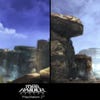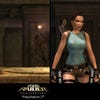Tomb Raider Trilogy
Crystal clarity.
The team at Crystal Dynamics got a lot right with Tomb Raider before players had even tried out a line of their code; before they'd contemplated their first ledge jump, fired off their first grapple hook, or investigated their first crumbling temple wedged deep behind the shimmering folds of a hidden waterfall.
The team got the voice right. Keeley Hawes finally gave Lara Croft a wry, charming, light sense of personality, wiping away years in which Eidos' heroine sounded like a local radio continuity announcer juggling six children, a failing marriage and a heavy migraine. Hawes brought a little warmth and wit to the pencil-thin construction, and fleshed out the character in a way that the – guess what? – tragic back-story never could.
Now I sound like a weirdo. Luckily, casting isn't the only thing the new developer worked wonders with, because the games themselves aren't half bad, either. Tomb Raider Trilogy gives you a chance to look at the full sweep of them. While Crystal Dynamics readies its latest reboot – this one will shove Croft back into her early twenties and tip her out onto a mysterious island filled with complex nut-jobs – PlayStation 3 types get to see Legend, Anniversary, and Underworld all on one disk.
It's an opportunity to chart the fortunes of a developer wrestling with an inherited video game classic as the team leads the adventurer through reinvention, reimagining, and finally a mild reworking for current-gen consoles. Far beyond the shimmery facelift that marks this out as an HD updating, then, it's a fascinating trip.
Let's get the HD part out of the way first. While Underworld's been available on the PlayStation 3 since its release in 2008, it's the first time out for Legend and Anniversary. Both games are present here in versions very similar to their HD upscalings for the Xbox 360.
They run at 720p, according to a weird pop-up in the corner of my television that I haven't been able to turn off yet, and although there might be minute differences, my fairly unscientific comparison of loading the PS3 and 360 games up, switching back and forth dead fast and squinting suggests they're pretty much identical. The only major difference I can detect is that Croft's skin appears to be – and look away, I'm about to use a technical term here – a little shinier on the PS3 version of Anniversary. Perhaps it's hotter inside a PlayStation.
Beneath all that, however, both games have held up very well anyway. The upscaling hasn't been kind to the jagged edges of shadows, but the overall art style has aged nicely, and the animation is still dazzlingly elegant as Croft swings from bars, leaps from tiny spars of rock, and falls, flailingly, to a series of entirely avoidable bone-crunching deaths.
More importantly, they've held up as adventures, too. Legend still feels like the sympathetic departure that it was so clearly meant to be, with its physics puzzles, shorter, snappier levels and fondness for modern settings, while Anniversary updates a fan-favourite itinerary with prettier environments and smarter traps.
Legend certainly seems the most interesting game. The storyline careers from one exotic hot spot to the next, while Tokyo, with its opportunities for clambering over advertising hoardings and zipping around under huge, neon skyboxes, makes for some of my very favourite Croft moments of all time.















